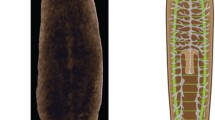Abstract
The trade-off between traits in life-history strategies has been widely studied for sexual and parthenogenetic organisms, but relatively little is known about the reproduction strategies of asexual animals. Here, we investigate clonal reproduction in the freshwater planarian Schmidtea mediterranea, an important model organism for regeneration and stem cell research. We find that these flatworms adopt a randomized reproduction strategy that comprises both asymmetric binary fission and fragmentation (generation of multiple offspring during a reproduction cycle). Fragmentation in planarians has primarily been regarded as an abnormal behavior in the past; using a large-scale experimental approach, we now show that about one third of the reproduction events in S. mediterranea are fragmentations, implying that fragmentation is part of their normal reproductive behavior. Our analysis further suggests that certain characteristic aspects of the reproduction statistics can be explained in terms of a maximum relative entropy principle.
Similar content being viewed by others
References
Agata, K.: Stem cells—from hydra to man. In: Stem Cells in Planarian, pp. 59–74. Springer, Berlin (2008)
Baguna, J., Slack, J.: Planarian neoblasts. Nature 290, 14–15 (1981)
Baguna, J., Salo, E., Auladell, C.: Regeneration and pattern formation in planarians. III. Evidence that neoblasts are totipotent stem cells and the source of blastema cells. Development 107, 77–86 (1989)
Boyce, M., Perrins, C.: Optimizing great tit clutch size in a fluctuating environment. Ecology 68, 142–153 (1987)
Bronstedt, H.V.: Planarian Regeneration. Pergamon Press, Elmsford (1969)
Calow, P., Beveridge, M., Sibly, R.: Heads and tails: adaptional aspects of asexual reproduction in freshwater triclads. Am. Zool. 19, 715–727 (1979)
Charnov, E., Ernest, S.: The offspring-size/clutch-size trade-off in mammals. Am. Nat. 167(4), 578–582 (2006)
Dunkel, J., Talbot, J., Schötz, E.-M.: Memory and obesity affect the population dynamics of asexual freshwater planarians. Phys. Biol. 8, 026003 (2011)
Hori, I., Kishida, Y.: A fine structural study of regeneration after fission in the planarian dugesia japonica. Hydrobiologia 383, 131–136 (1998)
Hori, I., Kishida, Y.: Further observation on the early regerates after fission in the planarian dugesia japonica. Belg. J. Zool. 131(Supplement 1), 117–121 (2001)
Jaynes, E.T.: Prior probabilities. IEEE Trans. Syst. Sci. Cybern. 4(3), 227–241 (1968)
Kawakatsu, M.: An experimental study of the life-history of Japanese freshwater planaria, p. vivida (ijima et kaburaki), with special reference to the fragmentation. Bull Kyoto Gakugei Univ. Ser. B, pp. 35–39 (1959)
Kullback, S., Leibler, RA: On information and sufficiency. Ann. Math. Stat. 22(1), 79–86 (1951)
Mora, T., Walczak, AM, Bialek, W., Callan, C.G. Jr: Maximum entropy models for antibody diversity. Proc. Natl. Acad. Sci. USA 107, 5405–5410 (2010)
Newmark, P., Sánchez Alvarado, A.: Not your father’s planarian: a classic model enters the era of functional genomics. Nat. Rev. Genet. 3, 210–220 (2002)
Oviedo, N.J., Levin, M.: Smedinx-11 is a planarian stem cell gap junction gene required for regeneration and homeostasis. Development 134, 3121–3131 (2007)
Peter, R., Ladurner, P., Rieger, R.: The role of stem cell strategies in coping with environmental stress and choosing between alternative reproductive modes: turbellaria rely on a single cell type to maintain individual life and propagate species. Marine. Ecology 22, 35–51 (2001)
Pettifor, RA, Perrins, C.M., McCleery, R.H.: Individual optimization of clutch size in great tits. Nature 336, 160–162 (1988)
Reddien, P., Sánchez Alvarado, A.: Fundamentals of planarian regeneration. Annu. Rev. Cell Dev. Biol. 20, 725–757 (2004)
Reddien, P., Oviedo, N., Jennings, J., Jenkin, J., Sánchez Alvarado, A.: SMEDWI-2 is a PIWI-like protein that regulates planarian stem cells. Science 310(5752), 1327–1330 (2005)
Sánchez Alvarado, A., Newmark, P., Robb, S., Juste, R.: The Schmidtea mediterranea database as a molecular resource for studying platyhelminthes, stem cells and regeneration. Development 129, 5659–5665 (2002)
Sheiman, I.M., Sedel’nikov, Z.V., Shkutin, M.F., Kreshchenko, N.D.: Asexual reproduction of planarians: metric studies. Russ. J. Dev. Biol. 37(2), 102–107 (2006)
Sinervo, B., Licht, P.: Proximate constraints on the evolution of egg size, number and total clutch mass in lizards. Science 252, 1300–1302 (1991)
Sinervo, B., Doughty, P., Huey, R., Zamudio, K.: Allometric engineering: a causal analysis of natural selection on offspring size. Science 258, 1927–1931 (1992)
Smith, C.C., Fretwell, S.D.: The optimal balance between size and number of offspring. Am. Nat. 108(962), 499–506 (1974)
Smith, H.G., Kallander, H., Nilsson, JA: The trade-off between offspring number and quality in the great tit parus major. J. Anim. Ecol. 58(2), 383–401 (1989)
Stearns, S.: The Evolution of Life Histories. Oxford University Press, London (1992)
Thomas, M., Schötz, E.-M.: SAPling: a scan-add-print barcoding database system to track and label asexual animal colonies, in review (2011)
Visser, M., Verboven, N.: Long-term fitness effects of fledging date in great tits. Oikos 85(3), 445–450 (1999)
Walker, R., Gurven, M., Burger, O., Hamilton, M.: The trade-off between number and size of offspring in humans and other primates. Proc. R. Soc. B 275, 827–834 (2008)
Wehrl, A.: General properties of entropy. Rev. Mod. Phys. 50(2), 221–260 (1978)
Zaccanti, F., Farne, P.: Observations on fissiparity and spontaneous regeneration in two strains of agamic planarians (dugesia gonocephala and dugesia tigrina). J. Exp. Zool. 238, 319–324 (1986)
Author information
Authors and Affiliations
Corresponding author
Additional information
An erratum to this article can be found online at http://dx.doi.org/10.1007/s10955-012-0608-5.
Rights and permissions
About this article
Cite this article
Quinodoz, S., Thomas, M.A., Dunkel, J. et al. The More the Merrier?. J Stat Phys 142, 1324–1336 (2011). https://doi.org/10.1007/s10955-011-0157-3
Received:
Accepted:
Published:
Issue Date:
DOI: https://doi.org/10.1007/s10955-011-0157-3




